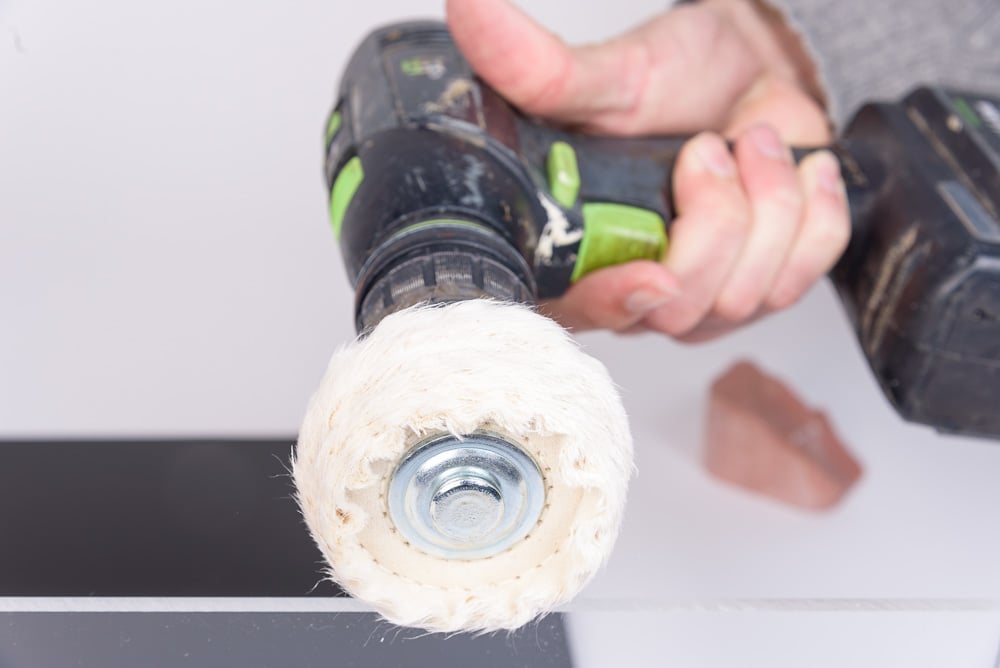Plastic sheets have many advantages over natural materials such as glass or ceramics. They are stronger, easier to work and much more impact-resistant. However, they are also more susceptible to scratching than glass, with intensive contact, light scratches may occur that can eventually make the surface dull. Fortunately, these scratches are easily removed by polishing the surface so that the sheet material looks like new in no time. In this article, we provide instructions and explanations about how to polish plastic.
Requirements for polishing plastic:
The differences between acrylic and polycarbonate
Acrylate and polycarbonate are the plastics that are most commonly used as finishing materials. Acrylate, better known as Plexiglass, is more sensitive to scratches than polycarbonate. It is important to know that there are two types of Plexiglass: the extruded and the cast form. Extruded Plexiglass is formed under pressure and therefore has many internal stresses. That tension is reflected in the processing: extruded Plexiglass breaks quickly and is sensitive to heat. This type of Plexiglass is more difficult to polish by machine because it can become viscous due to heat development.
Cast acrylic and polycarbonate are less affected by this, but it is important to keep a close eye on heat development during polishing. This is especially true for machine polishing with a polishing wheel.
Polishing the surface – remove light and deep scratches
Light scratches in the sheet material can easily be polished away with a soft microfibre cloth and a fine cut polishing agent. Always use a fine polish such as Xerapol, a polish for car paint is also suitable and even toothpaste can come in handy in an emergency. Moisten the cloth slightly and make a fold that you can hold between the thumb, index finger and middle finger. Apply a small amount of polishing agent to the cloth and make circular movements over the surface of the sheet. Make sure you polish a large area, not just the scratches themselves. This way you get a nice “transition” between the treated and untreated part. Allow the surface to dry for a while after polishing and then wipe it clean with a microfibre cloth.
TIP: treat the surface with Burnus Antistatic cleaner, the surface will stay beautiful longer.
Deep scratches require some roughening with sandpaper. Sand the scratch flat with grit 200, then sand a slightly larger area with grit 400 followed by grit 800. After this, you can polish the surface as described above. You can also use Zvizzer Heavy Cut polish. This polishes deeper scratches from the plastic, this can be done by hand or by machine.
You can polish the entire surface with a polishing disc in the drill or polishing machine. Always use a soft woollen disc and start with a low speed. You apply the polishing agent to the sheet material, just like a car being waxed. Then polish the surface with the machine, do not exert too much pressure but let the machine do the work. Once the entire surface has been polished, go over it again with the polishing machine, this time at medium speed and with minimal pressure.
Polishing edges
After machining, machining traces are always left on the edges. We make a distinction between the saw stroke and the machine stroke; a saw stroke remains after the cutting of sheet material, machine stroke is the result of machining such as milling. A saw stroke has deeper grooves than a machine stroke. It is possible to polish the edges of plastic sheets so that they are completely smooth again. With a saw stroke, start sanding with grit 80, sand the deepest grooves smooth with this. Next, sand the edges with grits 200, 400 and 800. Finally, polish the edges with a backing pad with polishing wool in the drill. Use Xerapol, Zvizzer or an equivalent polishing agent, apply the polishing agent to the patch and distribute it over the edge of the sheet at low speed. Start polishing at a low speed and assess the result continuously. Do not apply too much pressure, as this will damage the patch and lead to extra heat. The edges will be crystal clear again in no time.
Flame polishing Plexiglass edges
You can also polish the edges of acrylic sheet with a burner. It is important that the edges are first sanded according to the instructions above. It is best to use a propane burner – a butane burner is not suitable. The burner must have an adjustable flame with which a “pencil flame” can be formed. Light the burner and move the flame quickly along the edge. Make sure that the cone (the bright part in the flame) does not touch the edge, otherwise the edge may melt. Pay close attention to the edge when burning, the heat will melt and close the surface. It is advisable to first try flame polishing on a leftover piece.

